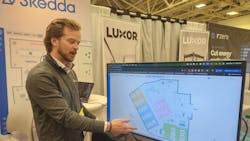8 Worktech Solutions to Increase Efficiency and Deliver Value (IFMA 2025)
Intelligent worktech can do more than make your life easier—it can affect your ability to drive value. About 50% of businesses are using an average of 17 standalone worktech solutions, according to worktech provider Eptura’s 2025 Workplace Index, and the need to rely on multiple data dashboards is slowing people down. The study found that 37% of organizations use 11 or more employees to collate, analyze, and report on their worktech data, which illustrates how fragmented data is within many organizations.
“Facility managers, building managers, and workplace managers are managing data from a ton of different systems,” explained Erin Sevitz, vice president of content and customer marketing for Eptura. “That data tends not to be very standardized, and there’s not a lot of commonalities in it. But any time you want to make changes or add new technology, getting a baseline of what your real current state is, is incredibly important.”
These exhibitors at IFMA World Workplace 2025 showcased technology engineered to streamline facility management tasks, increase accountability, and improve the user experience.
FMClarity: Simplify Day-to-Day Operations
Originally introduced in Australia, FMClarity is a facilities and asset management software solution that end users, suppliers, contractors, and technicians can all use to manage buildings and communicate with each other. The intuitive platform lets end users enter requests in a simple mobile- or web-based interface and upload documents, which are automatically filed based on the site and service. Documents are also shared with contractors who enroll in the platform so they have the right background information to do their jobs. Work orders are tracked on the same platform, letting facilities professionals see at a glance which orders were completed on time, late, overdue, or are not yet due. QR codes attached to assets in the field make it easy to see what maintenance was done previously.
The key to implementing a system like FMClarity is considering the needs of all users, not just one group, explains founder and CEO Richard Ham.
“If a system is considered, you need to be considering all different user groups,” Ham said. “It’s not sufficient to implement a system where it’s only delivering an outcome for the executives or for facility management, because if multiple systems have to be used to facilitate those outcomes, then you’re really hurting your ROI. You’re creating a lot of inefficiencies in that workflow, and that time can be better spent.”
Occuspace: Allocate Space Smarter
Occuspace uses AI-enabled sensors to help users right-size spaces in commercial facilities, explained CEO and co-founder Nic Halverson. The sensors collect data anonymously and plug into a wall outlet, so no batteries or infrastructure changes are required. They’re most commonly used for four main use cases, Halverson said:
- Changing how space is allocated for offices, departments, or agencies. Departments may have many more desks than they have people coming into the office to use them; finding these inefficiencies across organizations can enable companies to reduce their footprint or even find a different space that’s closer to the right size. Colleges and universities can avoid building new facilities.
- Optimizing HVAC scheduling based on how many people are actually in the space.
- Delivering custodial services where they’re needed instead of spending the same amount of time and resources on floors or areas that are underutilized.
- Reducing food waste by giving food service providers a better understanding of how many people are actually in the building.
“It doesn’t have to be a portfolio-wide deployment,” Halverson said. “That’s what everybody wants, but you can start with a floor, with one building, or with 1,000 square feet of space. Get your hands on data and really understand how this data is going to be used… Start small, test the change management and the real implementation of decisions at a smaller scale, and then go big when it works.”
Skedda: Make RTO Easier
Skedda, a workplace and space management platform, helps organizations manage access to bookable resources at scale across their workplaces, explained Jake Helman, SVP of sales and partnerships. Facility leaders gain insights on how people are using their workstations. The interactive, map-based booking solution displays the company’s floorplan with clearly labeled bookable objects, giving users a quick point-and-click booking experience. Each bookable desk or space shows what features it has, such as the availability of a standing desk or its location in the sales team area.
Skedda integrates into Outlook and Google Calendar, so bookings made in other calendar systems show up automatically in the platform. This integration “allows us to make sure we’re in front of the team where they already are instead of trying to get them to do an entirely new process,” Helman said. “No matter what, SaaS is not a silver bullet. There has to be a large change-management process that comes into play. Make sure you’re thoughtful about how your users will use the space in conjunction with the technologies.”
Facilities managers are increasingly discovering that the workplace experience is at least partially on their plates, added Jenny Moebius, Skedda’s SVP and head of marketing and host of the Heroes of Modern Work podcast.
“It’s not just connecting the buildings, it’s about connecting the people—especially since lots of people are engaged in hybrid work, two to three days a week [in the office] versus all five days,” Moebius said. “Facilities managers really need to stay on top of that.”
Eptura: Comprehensive Workplace Management
Eptura’s workplace solution covers all aspects of the built environment from space planning and portfolio utilization to the employee and visitor experience to asset management and maintenance. Space planners might use the app to start mapping layout scenarios in a new building, while maintenance techs can see what parts they need to fulfill a work order. Before starting, it’s a good idea to spend time on change management and prepare people for the switch to any new technology solution, Sevitz said.
“Having a good understanding of the end state you want to achieve and what good looks like to you is really important for any kind of implementation,” Sevitz advised. “Pay attention to the change management aspect, whether you’re changing technology or any other kind of change you’re making in the workplace. It’s incredibly difficult if you don’t get buy-in from all of your stakeholders up front.”
Maptician: All-in-One IWMS
The integrated workplace management solution Maptician delivers conference room management, seat management, visitor management, space management, and occupancy management under one umbrella, explained AshLea Allberry, the company’s chief operating officer. The space planning component features a full map-building engine that allows you to edit your floor plan in its entirety, down to a single window. The company also plans to roll out some AI-powered features within the next 60 days.
“Bookings should be so simple that everybody wants to do it,” Allberry said. “It shouldn’t be a burden.”
TRAX Analytics: Ease and Accountability for Custodial Staffs
TRAX Analytics is janitorial management software that alerts janitors “when to clean, where to clean, and how to clean, while giving complete transparency to the janitorial companies and building owners,” explained CEO Tracy Davis. The solution is in 73,000 locations nationwide and is utilized by more than 25 facilities management providers.
TRAX Analytics is easy to operate on iOS or Android and can also be paired with Bluetooth badges for custodial staff. Sensors deliver real-time data on dispenser levels and the number of guests who have used a restroom, lobby area, or other space, as well as guest feedback. The system allows users to start small with digitizing tasks and moving inspections away from paper logs, then scale up by pairing more sensors and adding more capabilities. “If you want to stay ahead of the game, I always recommend getting those champions internally to get comfortable with the technology and share the excitement with the rest of the team,” Davis said. “That’s when we see the most success.”
Nimble Energy: AI-Driven Energy Management
A three-year-old startup company, Nimble Energy provides utility bill and meter data capturing with AI-powered analytics. “It gives you the ability to drive future energy initiatives, identify energy waste, and then find ROI for an energy audit or any kind of energy project,” said Nate Eicher, enterprise account executive. “It empowers facilities managers who are battling pressure from leadership or legislation to now be energy managers as well. Many of them don’t have the staff, resources, or time to do that. The way we look at it is, we’re a virtual energy manager for you.”
The tool allows facilities professionals to find anomalies in energy billing and realize associated savings—making it easy to pluck the low-hanging fruit when it comes to energy management.
Sign In Solutions: Streamline Visitor Management
Sign In Solutions provides visitor management to small and medium businesses (SMBs) and also offers an enterprise solution, ensuring every size of organization can offer an efficient, safe guest experience. The enterprise version features automations, workflows, and deeper levels of compliance to ensure a guest is who they say they are.
Many organizations are still making the transition from untrackable paper logs, noted Josh Gilliam, VP of product and go to market strategy. “The ability to have that information in a digital format gives back to them in reporting, and now they have the ability with visitor management to understand who’s coming too so they can be more proactive and reactive,” Gilliam said. “Some of the challenges we hear are, I need to know who’s coming. When they’re here, I need to understand who they are and why they’re here, and when they leave, I need to understand the patterns and auditing. Digitization provides that.”
Visitor management solutions provide opportunities to satisfy the needs of several departments at once, Gilliam added, from facilities management to physical security and even cybersecurity.
“Many of the risks are brought in by people coming into your organization. Have a conversation about what they would like to know that they’re not getting today,” Gilliam advised. “What would make their job easier that the facilities manager can provide? I would also speak to those at the C-suite level, where they have a responsibility for the finances of that building. How can we as a facilities group better understand the data that we can provide to understand what it looks like to fully staff or heat the office? Start having conversations, look at what the gaps are for other functions, and understand where visitor management systems solve those gaps.”
About the Author
Janelle Penny
Editor-in-Chief at BUILDINGS
Janelle Penny has been with BUILDINGS since 2010. She is a two-time FOLIO: Eddie award winner who aims to deliver practical, actionable content for building owners and facilities professionals.

